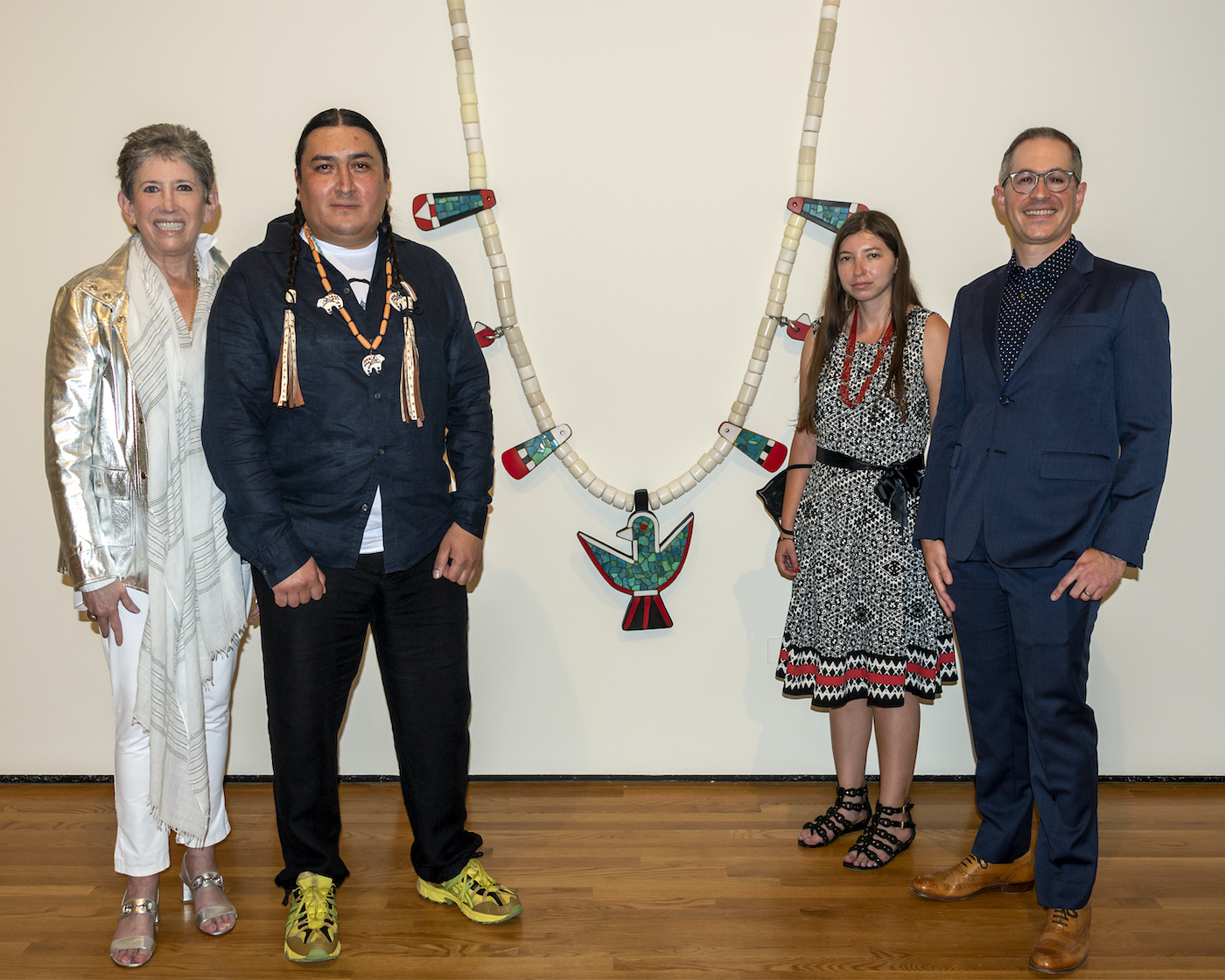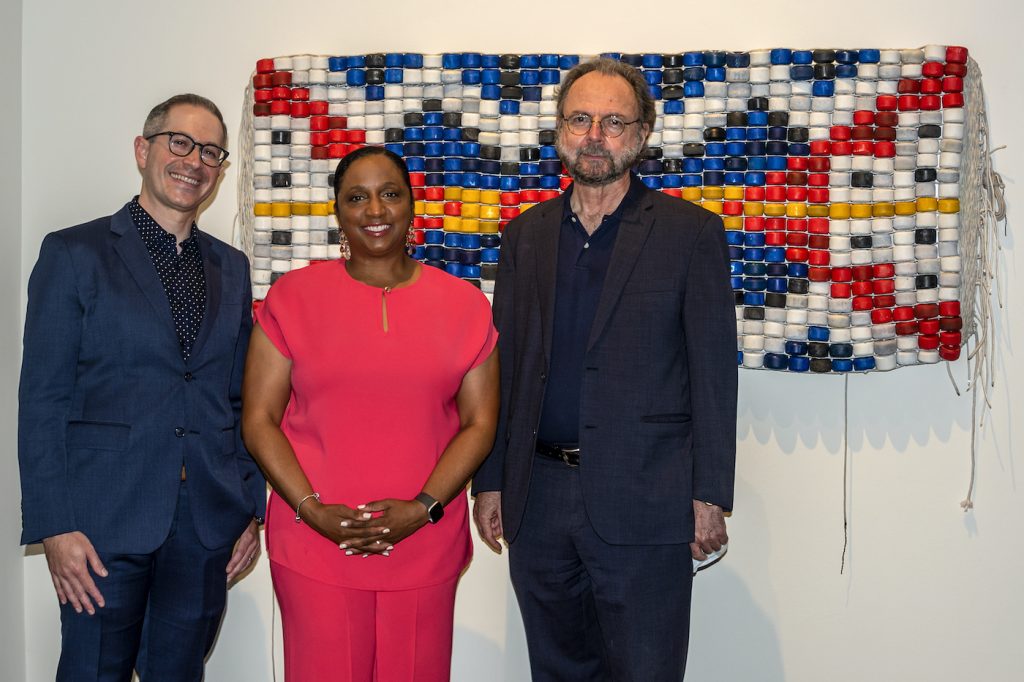Ishi Glinsky UCSB Retrospective Exhibit

I attended the opening of Ishi Glinsky’s solo exhibit titled Upon a Jagged Maze at the Art, Design & Architecture (ADA) Museum at UC Santa Barbara, sponsored by the ADA Museum’s Council. The exhibit is on view through January 22, 2023.
The 25 works from 2009 to 2022 were selected by museum Director Gabriel Ritter, PhD, and his Curatorial Research Fellow Kendall Lovely, with input from the artist. They are borrowed from the Forge Project, The Hammer Museum,and private collectors Roberto Cowan and Salima Boufelfel, Beth Rudin DeWoody, Karima Dennis, Ken Kajima, Alan Hergott and Curt Shepard, Sarah Hendler and Vinny Dotolo, Lisa Neimeth, Brett Robinson, Marc Selwyn, Sigit Nugroho, and Robert Shiell.
In terms of exhibiting and curating Native American and Indigenous art to be other than a cultural educator, one asks, does it need a purpose so museums and guests can acknowledge it? Gerald Clarke Jr., a Cahuilla sculpture artist, said in the L.A. Times, “It’s a trap because the default setting for mainstream America is that the artist is the ambassador of the community, and that almost replaces the interest in the artist’s own creativity.”While L.A.-basedNavajo multimedia filmmaker Pamela J. Peters said, “My work attempts to help deconstruct stereotypical depictions of Indians in films such as Pocahontas and The Lone Ranger that portray Indians as relics of a historical past. In my project Legacy of Exiled NDNZ and Indian Alley, I want to showcase an Indigenous aesthetic of ‘real’ Indians, as we are today… and how their tribal identities can not only exist, but also thrive in large urban
cities like Los Angeles.”
In Glinsky’s exhibit, we find art and the opportunity to be educated about issues he finds important and perhaps to drive social change. He is a self-taught sculptor, painter, and installation artist of Tohono O’odham and German descent, living and working in Los Angeles since 2006.
The layout of an exhibit can make or break it, and Ritter’s entrance placement of Glinksy’s Coral vs. King Snake Jacket (2019) [120x96x35 in.] finds true use of shock value via massive scale art as the centerpiece in a tiny space. All intrinsic psychological attributes to black leather motorcycle jackets work here – studs marking rebellion, patches with symbols of the American Indian Movement, and monogrammed messages like, “Yosemite means those who kill.”
Turning to the walls in the same room, we find Spitfire (2017) a sculpture of loomed beadwork where the beads are repurposed skateboard wheels he sourced from the coast of L.A. through Portland, Oregon – migration comes into play here, along with a nod to the Spitfire brand.
Selectively and singularly the large-scale indigenous necklaces, Worn Red (2016), Sunset (2022), and the Giant Breastplate (2009), that adorn the right wall are in direct contrast to the smaller-than-life-size scale of the sculptures titled Rain Warriors (2019), which sport long coats with symbols, a Nike logo, and carrying blankets, displayed in forward movement on AstroTurf stands in the left middle floor area. These warriors are further contra balanced with four “woven” sculptures titled Tohono O’odham Basket (2013), Tray (2014), Copper Chain (2016), and White Basket (2017) comprised of oxidized wire displayed on a white wood floor palette. This entire grouping is “experience medium” placement – a purposeful pairing of works that imply the commercialization of fine art, like Warhol, times the issues of Indigenous peoples. Also in the exhibit were mentions to his works on canvas, ledger art, and cartoon character series re-referenced, such as Snoopy the Red Baron titled, Geronimo (2021).
The themes, scale, symbols, and mediums used here are a directed homage to Indigenous issues not to be glossed over as history’s past. They are anointed with unapologetic, undeniable, and notably lampoon messages from the artist – do you recognize the Indigenous paint colors, the nuance of pop-culture x meme, what the Raining Warriors (2019) are saying; what is ledger art; does it provide catharsis and healing or does it serve the story-telling journey of the artist?
Read on Robert Hughes! Glinsky provides a brief reveal in our email interview:

Q. How do you interpret your messages in the art are being received?
A. The intention with my work overall is to open doors for viewers, or continue conversations if you may be aware, of some of the things addressed within the respective piece. I hope to inform and educate, and hope this comes across or is received in a positive manner. Generally, each of the works within Upon a Jagged Maze speak to a specific issue, depending on the medium choice or context they are created in. These are either movements that are presented in and throughout, such works as Coral vs. King Snake Jacket, or what I consider to be unsung art movements in Native American History. Throughout the show, each work has label texts speaking to the nuance and historical references of each piece, which Kendall Lovely, Gabe Ritter, and myself worked on to provide a sense of historical and personal context for the viewer. In addition, by the works selected for this exhibit, the idea was to create a presentation that told the story of steps I’ve taken through the years, touching on certain points and different mediums that I have worked within. Hopefully people can visit the exhibit and experience this for themselves.
When you create, is your focus on your Indigenous or German heritage?
Being both Indigenous and of German descent, the two halves of myself are inseparable – the content of the work aside – I bring a lot from my Mother’s German side to my practice, including simply being an artist overall.
Please comment on your use of scale.
Scale is meant to bring attention to, or create, new monuments to Indigenous movements. For Raining Warriors, the scale is different from the oversized work of Coral vs. Kingsnake, but many of the techniques to create both remain the same and each deals with Indigenous identity. This isn’t specific to one movement, but scale is used as a means to bring the viewer in, and once they are present, the further context of the piece can be shared and potentially further engaged with. Scale has been a continued presence in my work going back to the earliest piece in the show from 2009. Scale is employed depending on the work being created and each piece is executed deliberately.
Your projects for 2023?
I have a few things I will be focusing on for 2023, new sculptures and paintings mostly. I am excited to continue working towards this. Looking forward to my solo show at Chris Sharp Gallery in late Spring 2023. The other project I am working on hasn’t been announced yet. I am considering taking on interns in the near future, but no plans to teach.
Guests at the opening included the newly appointed Michael Douglas Dean of Humanities and Fine Arts Daina Ramey Berry,PhD; artist Toni Scott; Beth Rudin DeWoody with her husband, Firooz Zahedi;MSW UCSB Director of Development Academic Programs Sudi Staub; and UCSB Vice Chancellor David Marshall.






